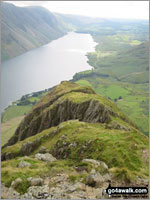How to walk down hills: skills for hill walking

It's easy to assume that walking up the hills is going to be the most difficult aspect of a day's walking.
However, it doesn't take long to realise that walking down the hill can also be quite challenging and - if approached in the wrong way- can increase the risk of joint damage particularly in your knees and ankles.
Long downhill stretches are frequently also undertaken at the end of a long day's walking when tired bodies (and minds) mean that slips and falls are often more likely.
Before you go
As ever, being kind to your feet is really important. Blackened toenails aren't a great look for most of us and they are a sure sign of an ill-fitting boot - and this will be a particular problem when going downhill.
Make sure your boots fit well - your heel needs to be held firmly - so make sure your boot is the best shape for your feet and that you tighten the laces adequately. Your toes shouldn't bang against the front of your boot.
For more info see how to choose a pair of walking boots
It's important to maintain the stability of your knee when going downhill, and this may be helped greatly by exercises to strengthen the muscles around your knee.
If you have existing hip/knee problems, then it's worthwhile getting a biomechanical assessment done. It's really not unusual to discover that you have a gait problem which can be readily improved by the use of an inner sole or an orthotic. (Speaking personally, the impact of this on your walking can be really quite transformational!)
On the hill
Your posture is very important. Don't lean back as this will send you out of balance. Instead keep upright or lean slightly forward. Your weight should be over your hips and knees which should be slightly bent particularly as you put your foot down.
Your stride will lengthen automatically - to control your speed, shorten it.
Try not to angst too much if your feet slip slightly - remember to keep your weight forward and try to just go with it. You're not in a race - so slow down.
If at all possible, pick out a zig-zag route downwards - this will reduce the overall impact on your joints and enable you to better control your speed and provide a greater sense of security.
Dealing with scree is pretty much the same as when going uphill. (See How to improve your hill walking technique). If it's unavoidable, go slowly, try to keep your foot flat, try to step onto larger, flatter stones or clumps of vegetation and look out for other walkers above and below you.
Grass slopes - particularly if wet - can also be challenging. Again, rather than heading straight down, try to pick a route that will allow you to aim for a series of flatter spots. This way you're more likely to be able to stop any 'slide', rest . . . and to take in the view.
Walking Poles
Many people find walking poles particularly useful when going downhill. Try to buy poles with a good shock-absorbing system. When using them, place the pole slightly in front and to the side before each step so that it takes some of the weight. A word of caution - it is possible to use walking poles in such a way as to cause problems - particularly if you have existing knee, hip or back problems. If that is the case, it's worthwhile getting some professional advice (from a physio or a physical therapist) first.
And finally . . .
As with most skills, the more downhill walking you do, the better will be your technique, the more confident you'll become . . . and the more likely you are to enjoy the whole day out.
“Walking down steep muddy hills when there is no alternative route I have used a walking pole by jamming it into the mud in front of me and then by placing the side of my boot against the pole have been able to descend quite safely using the pole as an anchor.”
Mark Hamer, Cardiff
To add your comment to this article - click This Link.
We look forward to hearing from you.




















